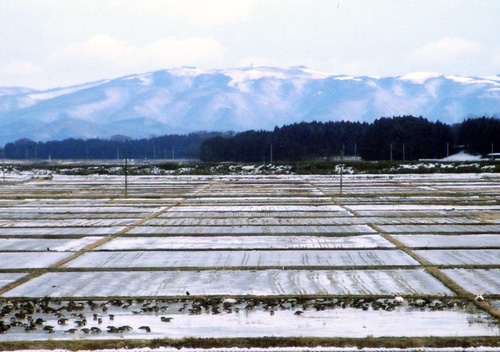
from Japan vol. 56 2011.04.08 The boundless power of "winter-flooded rice fields," which balance delicious grains of rice with biodiversity
![]()
- The Ramsar Triangle
- Land loved by waterfowl
- Great white-fronted geese rush home
- What are winter-flooded rice fields?
- Rice paddies are one of the big 3 ecosystems of the 21st century!
- The 3 indexes. No.1: How many organisms live in the rice paddies?
- The 3 indexes. No.2: It's not just about rice. The boundless power of rice paddies.
- The 3 indexes. No.3: There's rich fungus right by our feet
- Positive thinking and a new evaluation system!
- "Winter-flooded rice fields" bring the world closer
Against the crips, clear winter sky, "winter-flooded rice fields" are strikingly beautiful. Ordinarily, when the autumn harvest season nears, water is drawn from the paddies and the land is laid fallow. But rice paddies that remain flooded in the winter are home to a wide range of wildlife – migrating birds stop by to feed or rest and microorganisms and sludge worms remain active throughout the winter season. The movement to keep rice paddies flooded in the wintertime began in 1997, and this movement has gradually begun to spread across the nation. Kabukurinuma located in Osaki city, Miyagi prefecture, is a particularly special place; in 2005 it and the rice paddies including those kept flooded during the winter time in the surrounding area became the first site to be registered as a Ramsar wetland in accordance to the Ramsar Convention on Wetlands*. Mr. Shigeki Iwabuchi, the chairman of the specified nonprofit corporation, "Tambo" (meaning rice paddies), which conducts research on rice paddies as a sophisticated ecosystem and shares the findings with the rest of the world, gave me a tour of the rice paddies. (Title photo: Shigeki Iwabuchi)
目次へ移動 The Ramsar Triangle
Mr. Iwabuchi lives in Osaki city, Miyagi prefecture. It is about 1.5 hours on a bullet train from Tokyo, 50km northeast of Sendai city. When I went in mid January, the temperatures outside were nearly zero degrees Celsius. Strong, cold winds blew and snow danced in the air. My body, unaccustomed to such brisk cold became tense. This region is accustomed to strong winds as it is sandwiched in the East and West by the Ou Mountains and the Kitagami Mountain System.
There are 3 Ramsar wetlands in Miyagi - the Kabukurinuma and the rice paddies in its periphery, Kejonuma, and Izunuma/Uchinuma up north. Because these 3 locations form a triangle, the people in the region refer to the 3 wetlands as the "Ramsar Triangle."
It is globally rare that 3 registered wetlands are located within 10km of each other. These wetlands have met the criteria used for selection - "regularly hosting over 20,000 waterfowl," and "regularly supporting over 1% of the local population of any particular species (subspecies) of waterfowl" - so you can see that this land is truly loved by birds.
*The Ramsar Convention on Wetlands - official name of the convention is "The Convention on Wetlands of International Importance, especially as Waterfowl Habitat." It was named after the town in Iran where the convention was signed in 1971. Japan joined the convention in 1980. 159 countries (as of April 2011) that have signed the convention meet once every 3 years.
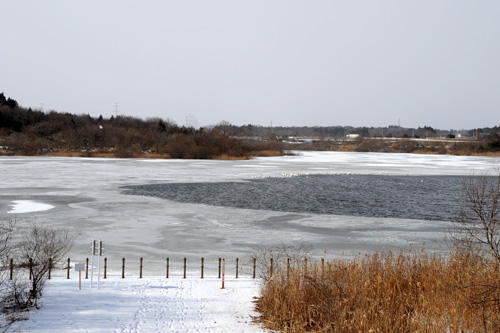 One of the Ramsar wetlands, Kejonuma. The name comes from a legend about a beautiful damsel who transformed into a snake.
One of the Ramsar wetlands, Kejonuma. The name comes from a legend about a beautiful damsel who transformed into a snake.
目次へ移動 Land loved by waterfowl
While Mr. Iwabuchi showed me around the sights, I saw many waterfowl. I usually only see crows, pigeons or white-cheeked starlings, so it was refreshing to see so many different species of waterfowl.
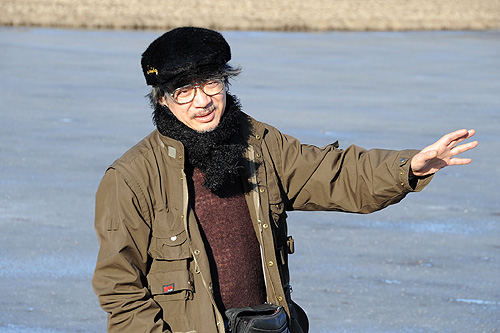 Mr. Shigeki Iwabuchi, chairman of the specified nonprofit corporation, Tambo.
Mr. Shigeki Iwabuchi, chairman of the specified nonprofit corporation, Tambo.
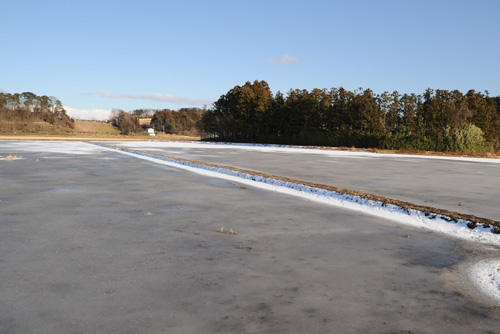 The first "winter-flooded rice field" I have ever seen. I was looking forward to this moment, but it was extremely cold at the first set of rice paddies we went to in Tajirikita Oshio that I felt frozen to the core.
The first "winter-flooded rice field" I have ever seen. I was looking forward to this moment, but it was extremely cold at the first set of rice paddies we went to in Tajirikita Oshio that I felt frozen to the core.
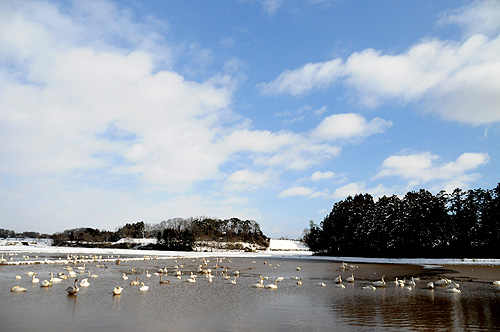 A Photo of the same paddy taken by Mr. Iwabuchi. Here, you can see many swans.
A Photo of the same paddy taken by Mr. Iwabuchi. Here, you can see many swans.
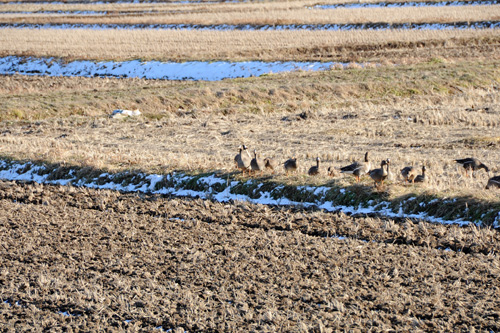 Great white-fronted geese we met on the way to Tajiri. I tried to get as close as I could, but there is still about 50 meters between us. They were all looking this way. I was told that a flock of great white-fronted geese have a tendency to look in the same direction. Mr. Iwabuchi said, "One of the reasons why the great white-fronted goose sightings have decreased is due to their extreme cautiousness."
Great white-fronted geese we met on the way to Tajiri. I tried to get as close as I could, but there is still about 50 meters between us. They were all looking this way. I was told that a flock of great white-fronted geese have a tendency to look in the same direction. Mr. Iwabuchi said, "One of the reasons why the great white-fronted goose sightings have decreased is due to their extreme cautiousness."
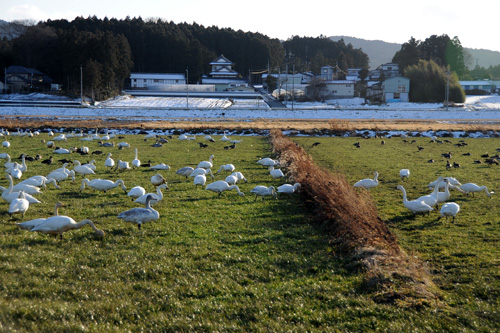 Next, we came upon a large flock of swans and tundra swans. There are truly so many waterfowls in this region. Tundra swans cry sound like "Cococococo." And whooper swans cry as though they are sounding trumpets. The waterfowls were noisily talking to each other.
Next, we came upon a large flock of swans and tundra swans. There are truly so many waterfowls in this region. Tundra swans cry sound like "Cococococo." And whooper swans cry as though they are sounding trumpets. The waterfowls were noisily talking to each other.
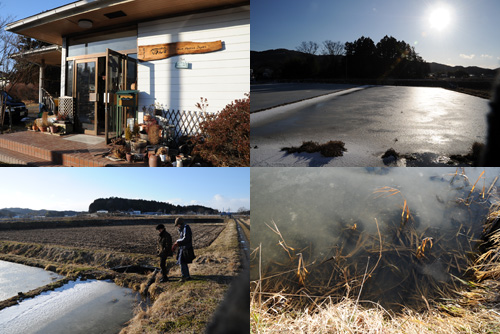 (Upper left) The office of the specified nonprofit corporation, Tambo. The wooden plaque was very stylish. (Upper right) The flooded paddy looks beautiful in the winter sunlight. (Lower left) Listening to Mr. Iwabuchi talk about winter-flooded rice fields. (Lower right) Even though it was the middle of winter, there were a lot of organisms in the water.
(Upper left) The office of the specified nonprofit corporation, Tambo. The wooden plaque was very stylish. (Upper right) The flooded paddy looks beautiful in the winter sunlight. (Lower left) Listening to Mr. Iwabuchi talk about winter-flooded rice fields. (Lower right) Even though it was the middle of winter, there were a lot of organisms in the water.
We arrived at the office of the specified nonprofit corporation, Tambo, in Tajiri Onuki, as the sun began to set. There were naturally flooded paddies on the East side of the office.
Mr. Iwabuchi and the members of the nonprofit advocate and create winter-flooded rice fields without using any fertilizer*. He also serves as a manager and advisor of numerous citizens' groups. Mr. Iwabuchi worked as a teacher for a long time in Sendai, so he still conducts surveys of organisms in the paddies and holds fun, green education classes catered to children.
*Fertilizer-less cultivation refrains from not only using chemical fertilizer, but even organic fertilizers and pesticides. This type of cultivation aims to create soil rich in microorganisms and also relies on the power of nature to produce organic compounds.
For example, he lets children run through the rice paddies in their bathing suits calling them "human soil puddlers," show them a thrilling scene of snakes swallowing frogs whole, feed them miso soup made with freshwater clams from the rice paddies, let them touch the Tohoku salamander, and experience the smell and taste of the soil that has become thick with sludge worm feces, etc. These all stimulate the children's 5 senses.
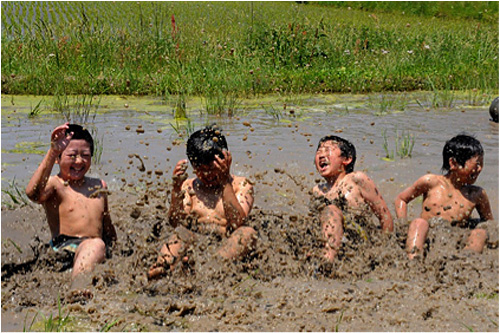 "Human soil puddlers" - It looks like they are having a great time at the
winter-flooded rice fields in the spring. (Photograph by Shigeki Iwabuchi).
"Human soil puddlers" - It looks like they are having a great time at the
winter-flooded rice fields in the spring. (Photograph by Shigeki Iwabuchi).
目次へ移動 Great white-fronted geese rush home
Kabukurinuma is well known for its great white-fronted geese. These geese reproduce in Siberia, and around mid September they migrated to Kabukurinuma. Due to hunting activities and urban development of their habitat after the Meiji era, their population decreased so much that they have become a protected species in Japan. It is said that currently, approximately 80% of all geese that migrate to Japan come to the northern part of Miyagi prefecture.
The beautiful sight of geese at dusk landing to settle down for the night has always been popular among people; Hiroshige Ando chose this very sight as a theme for his Ukiyoe painting, "The wide geese returning home at Katata - The Eight Views of Omi." When the geese return to the wetland, they rapidly decrease their speed in mid air, so they look as though they are slowly, gently falling down. There are many people who come to take a look at their technique. We were also able to spend some time to observe their mastery.
 Viewpoint strongly recommended by Mr. Iwabuchi. On the right you will see the Kabukurinuma wetlands, and on the left you will see a cluster of winter flooded rice fields of Shinpou region.
Viewpoint strongly recommended by Mr. Iwabuchi. On the right you will see the Kabukurinuma wetlands, and on the left you will see a cluster of winter flooded rice fields of Shinpou region.
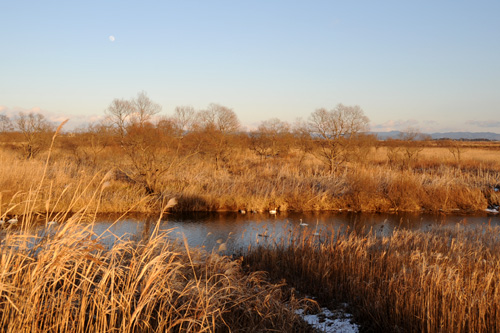 Although Kabukurinuma is referred to as a bog, it is really more like a wetland.
Although Kabukurinuma is referred to as a bog, it is really more like a wetland.
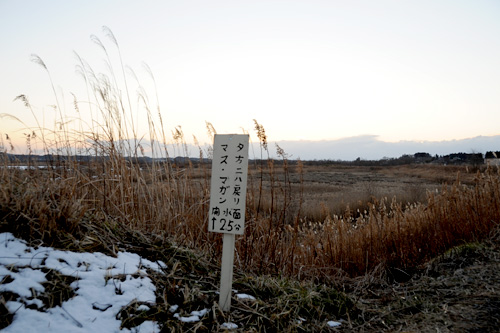 At first I thought it was a poem by the famous writer, Kenji Miyazawa, but it was a message from the geese. It reads, "We'll be back by sunset."
At first I thought it was a poem by the famous writer, Kenji Miyazawa, but it was a message from the geese. It reads, "We'll be back by sunset."
In the morning, the entire flock of geese takes flight from the wetlands, and they eat grains of rice that have fallen into the water in the paddies or grass during the day. At twilight they return from all directions, one after another.
We thought we were very quietly observing the water surface from among the reeds on the other side of the shore, but the geese noticed our presence and a flock of few thousands geese immediately took flight. The sound of their wings fluttering in the air was like a stadium full of spectators jumping up and down in the stands.
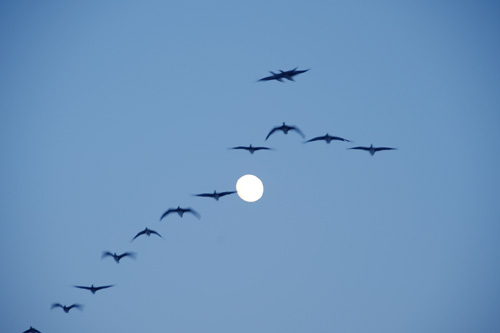 It was nearly a full moon when I was there.
It was nearly a full moon when I was there.
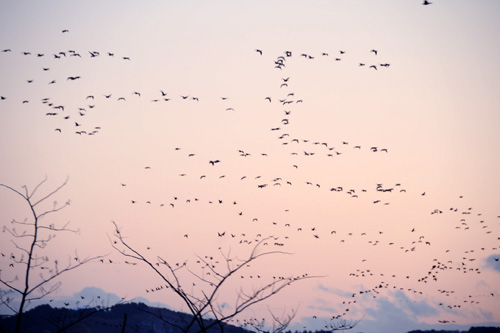 A rush home. I had never seen so many great white-fronted geese before. "Kiii, kiii" - their call to their families resonated through the air. Such multitude of geese crying at once reminded me of an orchestra tuning their instruments. I wondered if they were telling each other about their day.
A rush home. I had never seen so many great white-fronted geese before. "Kiii, kiii" - their call to their families resonated through the air. Such multitude of geese crying at once reminded me of an orchestra tuning their instruments. I wondered if they were telling each other about their day.
The great white-fronted geese fly in various patterns - sometimes they spread out like an umbrella, and at other times they form a straight line. Mr. Iwabuchi told me, "The geese end up flying in that formation because birds flying next to each other exhibit the desire to be close to its family."
With great appreciation for all the waterfowls that filled me with a rich, warm feeling, I left Kabukurinuma. During the winter, 70,000 great white-fronted geese return to the wetlands in Kabukurinuma every day; the people of the region enjoy this simple, yet heartwarming sight daily. I thought that perhaps this very feeling is what drove them to want to protect the wetlands and the rice paddies in the periphery.
目次へ移動 What are winter-flooded rice fields?
Let's dig a little deeper into the winter-flooded rice fields that are great for organisms and also for rice.
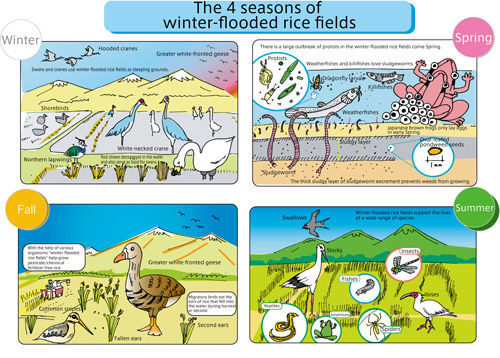 Winter-flooded rice fields are home to many organisms throughout the year. Illustration by Mr. Shinichi Tanaka, the main researcher at the Advice Center for Rural Environment Support (Acres) (click to enlarge).
Winter-flooded rice fields are home to many organisms throughout the year. Illustration by Mr. Shinichi Tanaka, the main researcher at the Advice Center for Rural Environment Support (Acres) (click to enlarge).
Please look at the illustration above. You can see that even in the winter, waterfowls come to the rice paddies to eat fallen grains of rice and grass. Bird excrement, which contains phosphoric acid and nitrogen, helps promote the reproduction of microorganisms in the water and creates natural fertilizer. Moreover, when the sludgy layer created by excrements of sludge worms and non-biting midges reach a certain thickness, it helps inhibit the growth of weeds in early spring. Algae, which conducts photosynthesis, also supplies oxygen to the fields and becomes feed for fishes such as killifishes.
Water management is a tough job for farmers, but if they could time their work well with the natural cycle of organisms, then they could reduce the use of agricultural chemicals, which in turn would reduce production costs. They would no longer need to use large farming machinery to till the land. Organisms will till the land for them throughout the winter.
Winter-flooded rice fields have quite a long history. In a document that dates back 340 years, it is mentioned that "fermented trash (organisms) from the rivers makes winter-flooded rice fields good for planting." We can presume that people even as far back as the 1680s knew that water high in organic constituents help promote the growth and activities of fungi and sludge worms. Mr. Iwabuchi refers to the writer of the document, Yozaemon Sase, as the "Superman of the Edo period." He conducted experiments on measuring the specific gravity of organisms and compiled a picture book of organisms. Yozaemon Sase with his versatile talent and sharp scientific eye had Mr. Iwabuchi speechless with admiration.
目次へ移動 Rice paddies are one of the big 3 ecosystems of the 21st century!
Mr. Iwabuchi went to visit the world's largest terraced rice paddies in Ailao Shan, Yunnan province, China, in mid January 2010. In the mountain region where the ethnic minority, the Hani tribe live, there are rice fields that have been flooded in the winter since 1,300 years ago.
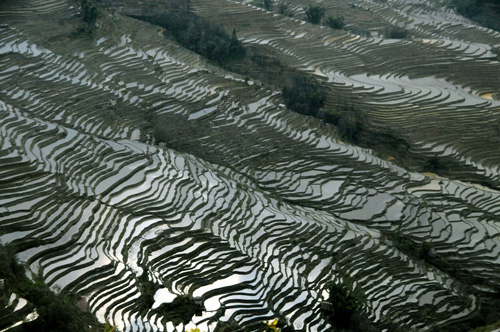 Terraced rice paddies in Yunnan that have traditionally been flooded. These paddies have been registered as a world agricultural heritage site by the Food and Agriculture Organization's (FAO). (Photograph by Shigeki Iwabuchi).
Terraced rice paddies in Yunnan that have traditionally been flooded. These paddies have been registered as a world agricultural heritage site by the Food and Agriculture Organization's (FAO). (Photograph by Shigeki Iwabuchi).
Mr. Iwabuchi referred to the late Dr. Josef Margraf, who used to work at FAO, who moved to Yunnan after deciding it was his home for life. He established the TIanzi Center and conducted research on terraced rice paddies around the world.
Dr. Margraf listed the "tropical rainforests," "coral reefs," and "rice paddies" as the world's most important ecosystems that mankind needs to protect.
Paddies store nutrients that dissolved in the water, purify the water, and produce organic constituents. When compared to tropical rainforests and coral reefs, the scale may seem different, but they serve the same roles - rice paddies have an excellent absorption/purification system, store nutrients, and enrich biodiversity. Looking back, Mr. Iwabuchi said, "the impact this story had on him was indescribable."
Diagrams and geographical shapes that have self-similarity and thus are the same shape in its larger form or even when divided into smaller parts are called "fractals" in geometry. But when Mr. Iwabuchi heard from Dr. Margraf that tropical rainforests, coral reefs, and rice paddies are interconnected by the concept of fractals, he became certain of the unique values rice paddies offer.
目次へ移動 The 3 indexes. No.1: How many organisms live in the rice paddies?
Hearing all this makes you wonder how many organisms live in the winter-flooded rice fields. Children may ask, "So how many are there total?" When confronted with such a question, would the adults be able to answer?
Actually, there are people who got up on their feet and set to work on this daunting task. They are part of the committee that works on the biodiversity indexes and planning for rice paddies. This committee includes 16 people who have been studying various organisms, including Mr. Iwabuchi, who was in charge of birds, as well as nearly 100 researchers, farmers, NPOs, etc. who study and work on rice paddies, who got together to discuss a great number of issues.
Over 2 years, the committee looked into as many organisms as possible seen in the rice paddies, dikes, irrigation channels, reservoirs, fallowed farmland, etc. The list of all species that live in the paddies contains 5668 species. A revised version was published in March 2010, and in October of the same year, it received quite an enthusiastic response at the tenth meeting of the Conference of the Parties (COP 10) to the Convention on Biological Diversity held in Nagoya, Aichi.
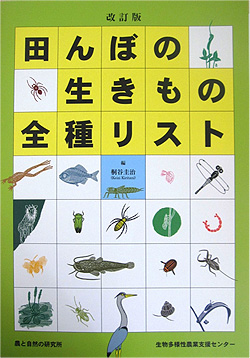 A list of all organisms that live in rice paddies.
A list of all organisms that live in rice paddies.
The list contains 2075 species of plants and moss, 1726 species of insects, 597 species of native species/blue-green algae, 205 species of viruses, bacteria, and fungi, etc. These species have been listed in 12 categories. You will discover some species you have never seen before or subtle species that you hadn't noticed before. A truly wide range of organisms is being introduced together with information about habitat distribution and biology.
Specified nonprofit corporation, Tambo created a poster to promote the 5668 species.
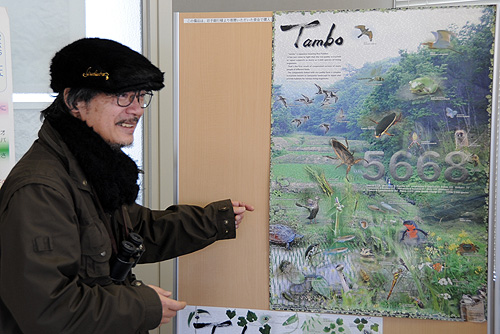 This poster was also exhibited at COP 10 held in Nagoya. If you take a closer look at the design of the background, you can see that the names of all 5668 species are written there. At international conferences, scientists from around the world lean in closely pointing at species they know or can find locally.
This poster was also exhibited at COP 10 held in Nagoya. If you take a closer look at the design of the background, you can see that the names of all 5668 species are written there. At international conferences, scientists from around the world lean in closely pointing at species they know or can find locally.
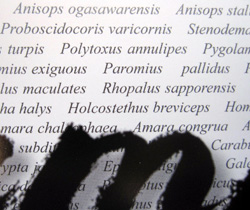 Close up of the top of the word, Tambo.
Close up of the top of the word, Tambo.
目次へ移動 The 3 indexes. No.2: It's not just about rice. The boundless power of rice paddies.
Farming started when mankind began to take advantage of nature to produce food. So we have an obligation to get involved in the rice paddies' environment, properly learn about the organisms that live there, and live in harmony with them. However, the current economic system only values efficient management and yield. A structure that also values multiple aspects of rice cultivation such as the preservation of biodiversity had not been developed.
In an issue of "Region Quarterly" published by Rural Culture Association Japan, the former ministerial aid of the Ministry of Agriculture, Forestry, and Fisheries, Mr. Yasue Funayama made the following statement.
The balance between supply and demand determines the price of rice. But as part of their farming activities, farmers flood their rice paddies, which helps prevent floods and help vegetation grow. They form settlements and protect traditional culture. They help create the beautiful landscape. But these efforts associated with farming are not at all reflected in the prices. (Excerpt from the August 2010 edition).
For example, the grasses on the dikes are carefully hand cut, without using herbicides. By taking such care, the biodiversity of the rice paddies change greatly. Although there are certification systems for production processes such as using none or less pesticides or organic farming, it is difficult to tell what organisms have been protected by such activities, and there are hardly any structures in place that can measure such day-to-day efforts.
That is why Mr. Iwabuchi and his team have pledged to create an unparalleled structure that will evaluate the positive effect on living organisms.
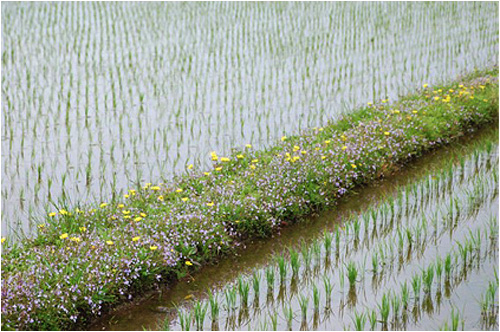 Wild flowers bloom on carefully tended dikes. (Photograph by Shigeki Iwabuchi).
Wild flowers bloom on carefully tended dikes. (Photograph by Shigeki Iwabuchi).
First, was there a way to properly value the work farmers put in to take care of the wild flowers, vegetation, and the rice paddies? Mr. Iwabuchi and his team thought. The specified nonprofit corporation, Tambo, created a list outlining the "boundless power of rice paddies," which contains 160 items that were a part of a wide range of farming activities such as the management of the rice paddies, surrounding irrigation channels, dikes, as well as taking care of nearby wetlands, reservoirs, and wooded areas, exchange with local children and the community, and even passing on food culture.
目次へ移動 The 3 indexes. No.3: There's rich fungus right by our feet
Moreover, Tambo is also involved in expressing the efforts of the farmers that we couldn't "see" in the past. Although there was a vague definition of "good soil" required to cultivate good crops, the recently developed, groundbreaking technology has made it possible to express such efforts quantitatively. Dr. Kazunari Yokoyama, professor of agriculture of the National Agricultural Research Center developed a new index that measures the biodiversity of microorganisms in the soil and the level of activity, so now you can scientifically prove the quality of soil.
Measurements can be taken rather easily. All you have to do is take a sample of the soil and place it in plates containing 95 species of organic substances such as glycogen. If organisms that feed on the various organic substances are present, the substances are digested, and carbon dioxide is released in the process. The plates will turn reddish purple in response to the carbon dioxide. A spoonful (approximately 1 gram) of soil from the rice paddies contain about 1 trillion fungi, and you can measure the biodiversity of the microorganisms in the soil and their activity level in 48 hours by looking closely at how the color changes and the speed at which the organic substances are broken down. Farmers with soil that produced results that are over the target level, receive stickers with a "Soil mark," which they can use to promote the fact that their produce has been cultivated with soil rich in biodiversity.
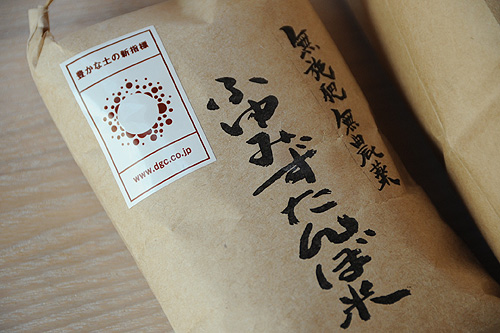 The composition of soil and that of space is similar? Rice cultivated in winter-flooded rice fields. It has the Soil mark, designed to resemble a universe coming to life, is affixed on the package.
The composition of soil and that of space is similar? Rice cultivated in winter-flooded rice fields. It has the Soil mark, designed to resemble a universe coming to life, is affixed on the package.
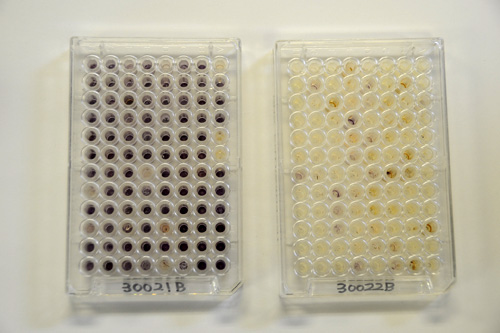 You can see that the microorganisms in the plates on the left have fed on the organic substances. The contents have turned reddish purple.
You can see that the microorganisms in the plates on the left have fed on the organic substances. The contents have turned reddish purple.
"There are researchers that continue to search for superman-like fungi in pursuit of efficiency, but actually, the presence of numerous fungi offers stable collective power, and thereby stabilizes production," says Mr. Iwabuchi. When you use chemical fertilizers and pesticides, the soil becomes thin, and will contain less organisms. Good soil, on the other hand, is one where many organisms are active. The technology, which has enabled the awarding of the Soil mark, is a pilot method developed from a big transformation in thinking - that is, recognizing that it is more important to take a comprehensive look at the activities of microorganisms in the soil, rather than to add what is missing.
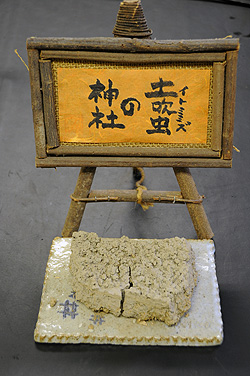 A cluster of dirt worms and fungi create in 1 year. It was enshrined in the Tambo office as an object of worship and there was a sign that read, "Temple of the Sludge Worm Gods."
A cluster of dirt worms and fungi create in 1 year. It was enshrined in the Tambo office as an object of worship and there was a sign that read, "Temple of the Sludge Worm Gods."
目次へ移動 Positive thinking and a new evaluation system!
A list of tasks that need to be undertaken to create rice paddies with boundless power has been drafted and there are new indexes. There is also a list of organisms that inhabit the rice paddies. Using the 2 lists and the new index, which are deeply interrelated, Mr. Iwabuchi and the staff at Tambo are making preparations to create a new framework for evaluation. Targets are: 50 items that contribute to creating rice paddies with boundless power, 70 species of organisms, and a figure of 70 in terms of the activity level of the soil.
Even if a specific activity may not be included in the list identifying contributing factors to rice paddies with boundless power, the activity will be included if it reflects the ingenuity of the individual farmer. "We want to be open and think positively. This is neither a regulation against pesticides nor a ranking system. It only evaluates the activities. It is important to have targets and to work towards them. The system should be an organic one, that incorporates the ideas of many people as we go along," said Mr. Iwabuchi.
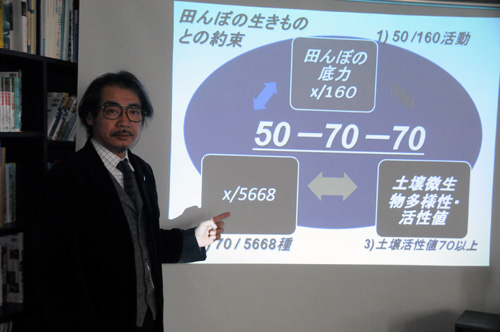 "We didn't use the word, 'certification' on purpose in order to emphasize that it has been created based on a completely different idea than normal ranking or evaluation systems (where regulations are applied or points are taken off). We wanted to use and for the new evaluation system to become known by a much softer expression, 'A declaration for and promise to the organisms that live in the rice paddies.'"
"We didn't use the word, 'certification' on purpose in order to emphasize that it has been created based on a completely different idea than normal ranking or evaluation systems (where regulations are applied or points are taken off). We wanted to use and for the new evaluation system to become known by a much softer expression, 'A declaration for and promise to the organisms that live in the rice paddies.'"
The goal in the future is to get consumers and companies also involved. The specified nonprofit corporation, Tambo, would like to get people to start taking a closer look at things around them, so Tambo is preparing a new structure for environmental activities - the "7 declarations for promoting the reproduction of organisms in rice paddies." This program will encourage farmers, general consumers, and companies to make 7 pledges of their choosing, each from their standpoint, to get more and more people to be compassionate towards organisms that live near them.
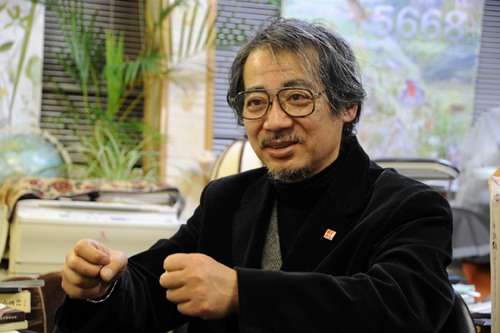 "We want people to feel free to make any declaration they want. It would be great if they could post their declarations on their walls or doors and think about what organisms they helped save every day."
"We want people to feel free to make any declaration they want. It would be great if they could post their declarations on their walls or doors and think about what organisms they helped save every day."
目次へ移動 "Winter-flooded rice fields" bring the world closer
The rice paddies in the Kabukurinuma area also have a global influence. The registration of Kabukurinuma as a Ramsar wetland, initiated joint efforts by Japan and Korea, which together made the following proposal, "Enhancing biodiversity in rice paddies as wetland systems," which was adopted as a resolution at the 10th Meeting of the Conference of the Contracting Parties (Ramsar, Iran 1971) (COP10) held in Changwon, Korea, in November 2008. Furthermore, at the tenth meeting of the Conference of the Parties (COP 10) to the Convention on Biological Diversity held in Nagoya, Aichi, the roles of rice paddies as a place for an extensive range of organism to flourish was highly appraised, and with the efforts of a Japanese NGO the proposal - "Enhancing biodiversity in rice paddies as wetland systems" - was also adopted as a resolution by the Convention on Biological Diversity.
This is an interesting story. It was back in 1997 that Japan began to flood its rice paddies in the winter, but farmers in the Ebro Delta in Spain and Sacramento Valley, California began to flood their paddies around the same time as well, as a way for waterfowl and farming to coexist. Mr. Iwabuchi strongly emphasizes, "It wasn't a coincidence. Time was ripe."
Mr. Iwabuchi refers to the list of 5668 species as "modern day Schindler's list for rice paddies*." Mr. Iwabuchi strongly believes that "we cannot lose even 1 species." Farming is a vital activity. We continue farming because we know that seasons change and new life will be born again the following year. But what if new life will no longer be born? "People think of biodiversity as an added value to economic activities, but biodiversity isn't an added value. It is the true value of farming. We should never forget that agricultural produce has life, that it is a living organism," said Mr. Iwabuchi passionately. I felt that that the key would be, how many people will be able to realize this.
*Schindler's list: In Poland, during World War II, a German businessman, Oskar Schindler, saved many Jewish people from being taken to concentration camps such as the Auschwitz. The list of Jewish people he saved came to be called "List of Schindler's Jews."
In 1880, 10 ares produced approximately 200kg of rice. In 1960s, the production capacity doubled to 400kg this was due to the rapid "industrialization" of farming. During the same time, the input energy (such as chemical fertilizers, machinery, infrastructure, etc.) surpassed the output energy, and farming became an industry that became heavily dependent on extensive petroleum consumption. Mr. Iwabuchi asks, can we really call the path farming has taken since the 1960s "evolution"?
It would also be "dangerous for winter-flooded rice paddies to spread rapidly. Diversity is also important to paddies," he cautions people who want to change the environment rapidly. Rather than focusing on specific organisms such as ducks or tadpole shrimp, farmers who support environmental conservation repeatedly spoke about the importance of balance. "We can produce better tasting rice when there are a wide range of organisms and even some weeds." Having come in contact with people who think about rice paddy farming, the oldest form of agriculture on Earth, at great length and who are implementing various actions to help protect it made me, as a general consumer, want to become more aware of rice paddies near my home.
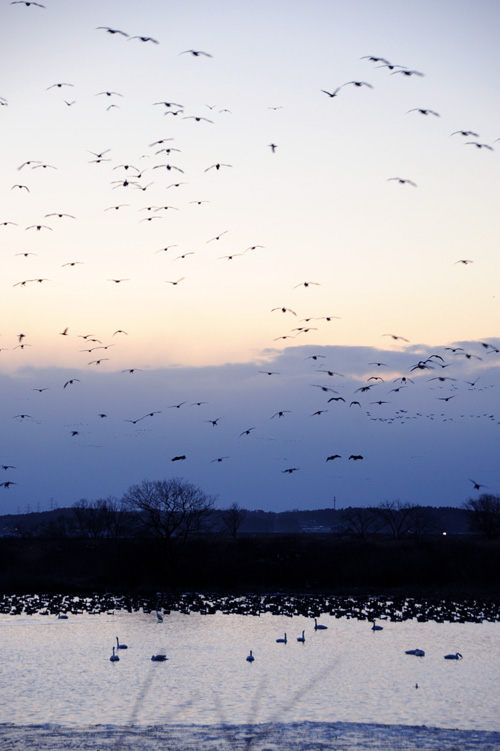
Mitsuko Iwai Biography
She has worked for a local museum/news paper publisher before she became a freelance writer. In 2002, she became involved in publishing a book of record of government's cultural programs and became intrigued with the ideas and lifestyles in the various regions that are passed down from one generation to the next. In 2004, she published the first issue of "Satomi Tsushin" which focuses on the theme, fixed-point observation of farms and farmers. She is also an as an editorial staff for the Earth News for the Think the Earth Project. She currently lives in Takasaki.
Reported and orginal Japanese text written by: Mitsuko Iwai
Translated by: Yuri Morikawa (oxygen inc.)
Photographs and edited by: Soichi Ueda (Think the Earth Project)















